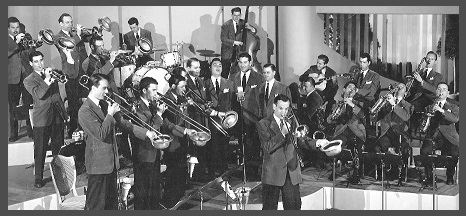To tell the story of classic rock radio, we have to go all the way back to the beginning. Not to when we crawled out of the primordial slime, but almost. The story of classic rock radio has roots going back to the 1940s, because people living in the 1960s grew up on music from the 1940s and 1950s.
Before there was such a thing as rock-n-roll, there was big band music. Big bands were dance bands, kind of like the rock bands of their day. The bikers in The Wild One (1954) didn’t listen to rock-n-roll. They listened to big band music. Big band music was the direct forerunner of 1960s brass bands like Chicago, Blood Sweat & Tears, Tower of Power, and Bill Chase. Brian Setzer and Big Bad Voodoo Daddy are keeping the big band sound alive.
What music did people living in 1940 already know? They knew a lot of classical music themes from movies and cartoons. Phonograph records and tube-powered radios had been around since the 1920s. In the 1940s, nearly all records were large discs played at 78 RPMs. The first “long-playing” (LP) 33 RPM albums came out in 1948. The first 45 RPM singles came out in 1949.
American audiences in the 1940s already knew a lot of music. They knew practically every song ever written by Stephen C. Foster, who died in 1864. Foster is called “the father of American music,” the first modern songwriter. Foster’s songs were taught in American schools through the 1960s.
Americans in the 1940s knew Gershwin’s “Rhapsody In Blue” (1924). They might have heard Stravinsky or Shostakovich. They might have heard Alban Berg’s Wozak. They listened to the Grand Ole Opry on the radio every week. They knew jazz trumpeters from the 1920s and 1930s like Bix Biderbeck, and Louis Armstrong.
Most people think of rock music when they think of electric guitar, but the electric guitar got its start in big band music. Charlie Christian was the first electric lead guitarist. His music is amazing because there was nothing before him to build on. No one had played guitar like that before.
Musical styles don’t fit neatly into decades. Many of these stars of the 1940s started their careers in the 1930.
In The Mood – Glenn Miller
Sing Sing Sing – Benny Goodman –
Take The A Train – Duke Ellington and his Orchestra
Boogie Woogie Bugle Boy – Andrews Sisters (How many times do they say “eight to the bar”?)
Boogie Woogie – Tommy Dorsey
Keepin’ Out of Mischief Now -Tommy Dorsey
Coconut Grove -Benny Goodman
Sent For You Yesterday – Count Basie
Stealing Apples – Benny Goodman and Lionel Hampton (From the 1948 film A Song Is Born. “We don’t use any music. We don’t have anything written down.”)
Swing To Bop – Charlie Christian
Grand Slam – Charlie Christian and Benny Goodman
Solo Flight – Charlie Christian and Benny Goodman
Stompin’ At The Savoy – Charlie Christian
Modern Big Band Albums
Big Band Voodoo – Dr John
King Of Swing – Big Bad Voodoo Daddy
